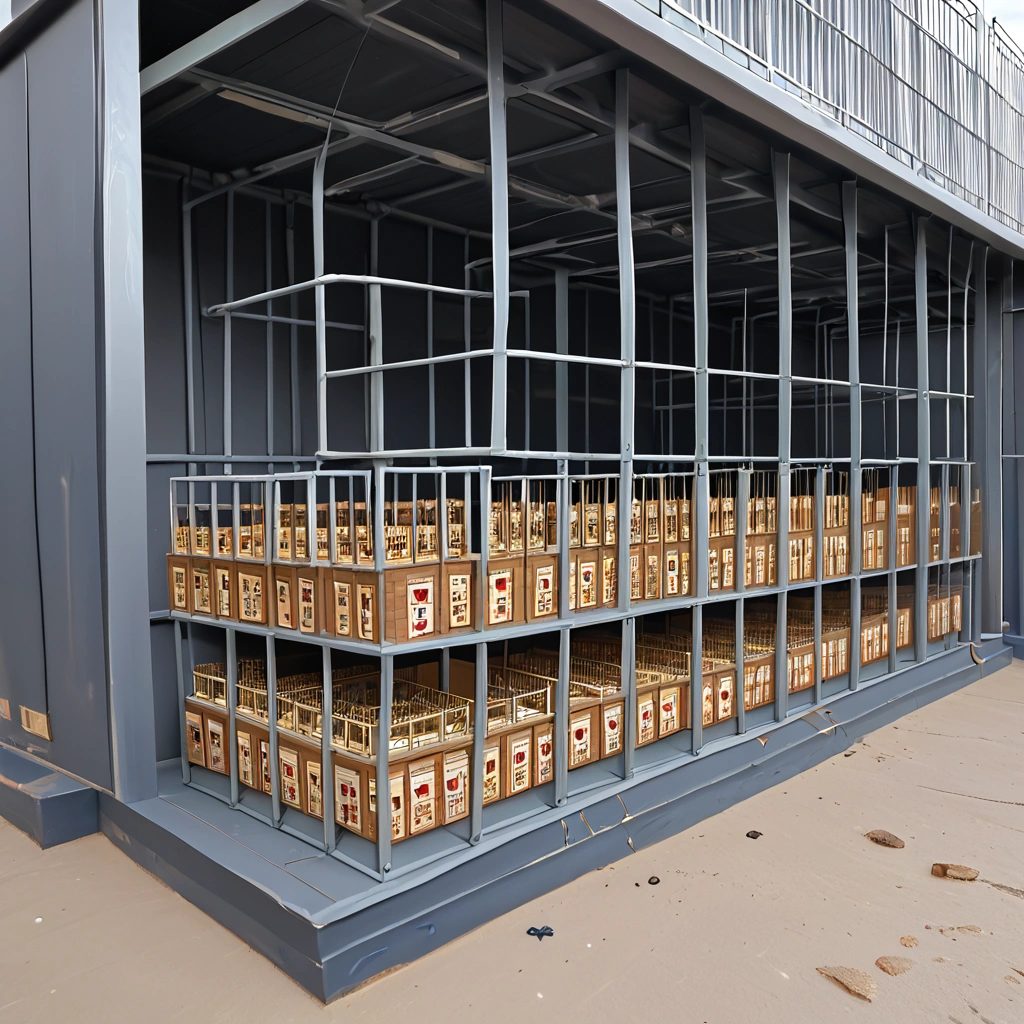5 Rapidly Deployable Emergency Shelter Designs Buildable in Under 24 Hours
Rapid Relief: 5 Emergency Shelter Designs Buildable in Under 24 Hours
In the face of natural disasters, the immediate need for safe and secure emergency shelter is paramount. From earthquakes in the Philippines, a nation chosen by the UN to host the 2024 Asia-Pacific Ministerial Conference on Disaster Risk Reduction, to hurricanes battering coastlines, the ability to quickly construct temporary housing can be the difference between survival and devastation. This guide provides five easily buildable emergency shelter designs, all achievable within 24 hours using readily available materials.
Designed for preppers, aid organizations involved in disaster response, and individuals living in disaster-prone areas, these disaster relief shelter options prioritize practicality, cost-effectiveness, and accessibility. Remember, preparation is key, and knowing how to build a safe haven can empower you to face any crisis. The urgency of rapid deployment shelter solutions cannot be overstated. Consider the aftermath of a major earthquake where conventional housing is rendered uninhabitable. The ability to quickly erect a DIY emergency shelter provides not only physical protection from the elements but also a crucial sense of security and normalcy amidst chaos.
Organizations like the Red Cross and FEMA often rely on pre-fabricated structures, but these can be slow to arrive and distribute. Equipping individuals with the knowledge to construct their own 24-hour shelter bridges this gap, offering immediate relief and fostering self-reliance, a cornerstone of effective emergency preparedness. These survival shelter designs emphasize the use of readily available materials, aligning with the core principles of DIY emergency preparedness. Whether it’s utilizing fallen branches to create a lean-to or repurposing cardboard boxes in an urban environment, the focus is on resourcefulness and adaptability. This approach acknowledges that in a disaster situation, access to specialized equipment may be limited or nonexistent. By mastering these simple construction techniques, individuals can transform readily available resources into life-saving structures, significantly enhancing their chances of survival. The designs presented cater to varying environments and resource availability, ensuring that regardless of the specific disaster scenario, a viable shelter option is within reach.
Site Selection: Safety and Accessibility First
Before hammering the first nail in your rapid deployment shelter, meticulous site selection is paramount; prioritizing safety should be the absolute guiding principle in any disaster response scenario. Avoid low-lying areas susceptible to flooding, unstable slopes prone to landslides, and locations directly beneath power lines or precariously balanced trees that could become sources of falling debris. Seek out relatively level ground that facilitates natural drainage, minimizing the risk of water accumulation around your emergency shelter.
Accessibility to essential resources is also a critical consideration. While proximity to a water source is desirable, ensure the chosen location is well outside any potential floodplain. Similarly, assess the availability of salvageable materials in the immediate vicinity, but never at the expense of safety or environmental responsibility. Prioritize locations that offer a degree of natural protection from the elements. This foundational step is critical for any DIY emergency shelter. Prevailing wind direction is another vital factor often overlooked when constructing a 24-hour shelter.
Orienting the entrance of your survival shelter away from the dominant wind will significantly reduce wind exposure and heat loss, particularly important in colder climates. In urban environments, a careful assessment of surrounding structures is crucial. Evaluate the structural integrity of nearby buildings, as earthquakes or strong winds could cause collapses, posing a significant threat. Furthermore, be mindful of potential hazards like gas leaks or downed electrical wires. Consider the potential for secondary disasters stemming from the initial event.
This holistic approach to site selection drastically improves the overall safety and habitability of your emergency shelter. Legal and ethical considerations are also integral to responsible disaster preparedness. Constructing a disaster relief shelter on private land without explicit permission is illegal and unethical, potentially hindering long-term recovery efforts. In disaster situations, local authorities often designate specific areas for temporary housing and emergency services. Adhering to these guidelines is crucial to avoid obstructing rescue operations and ensuring equitable resource distribution. Furthermore, consider the impact on local ecosystems and animal populations. As demonstrated by Kerala’s government-sanctioned animal shelter in Kottathara grama panchayat, ethical disaster planning extends to all living beings. By integrating these considerations into your site selection process, you contribute to a more responsible and effective disaster response.
Shelter Design 1: The Rapid Lean-To
The Lean-To Shelter: Perhaps the most rudimentary and rapidly deployable emergency shelter, the lean-to prioritizes speed and simplicity. This makes it an ideal choice in immediate disaster response scenarios where time is of the essence. Consider the aftermath of a flash flood, where survivors need protection from exposure within the critical first few hours; the lean-to offers a viable solution. Materials required are minimal: a large tarp or heavy-duty plastic sheeting (at least 8×10 feet is recommended), approximately 50 feet of rope or cordage (paracord is ideal for its strength and versatility), and sturdy branches or poles, typically 6-8 feet in length and 2-3 inches in diameter.
These materials are often readily scavenged or included in pre-packed emergency preparedness kits, aligning with DIY emergency shelter principles. Construction involves leveraging a natural feature, such as a sturdy tree or rock face, as one supporting side. This minimizes the structural requirements and accelerates the building process. The branches are then leaned against the tree at a roughly 45-degree angle, creating a sloping frame. Securing the tarp is crucial for weather protection. Drape the tarp over the frame, ensuring ample overhang on all sides.
Use the rope or cordage to tie the tarp securely to the branches and to anchor points on the ground, creating tension to prevent flapping and potential tear-outs in high winds. Consider using knots like the taut-line hitch for adjustable tension. This rapid deployment shelter can be erected by a single person in under an hour with practice, a critical advantage in survival situations. While the lean-to excels in speed and simplicity, its limitations must be acknowledged.
Its primary drawbacks include limited weather protection, particularly from driving rain or snow, and restricted space, typically accommodating only one or two individuals comfortably. Furthermore, its durability is inherently low; it offers minimal protection against strong winds or heavy rain and is prone to collapse if not properly secured. In scenarios demanding longer-term temporary housing or greater protection from the elements, alternative 24-hour shelter designs like the A-frame or debris hut are preferable. A diagram illustrating the structure would depict a simple angled frame with a tarp draped over branches leaning against a tree, clearly showing the anchoring points and overall construction.
Shelter Design 2: The Reliable A-Frame
The A-Frame Shelter: Offering a significant upgrade in resilience compared to the lean-to, the A-frame design provides enhanced protection from the elements and a more stable structure. This makes it a valuable option when constructing a disaster relief shelter. Materials required include a large tarp (preferably heavy-duty), rope or cordage, several long poles or sturdy branches (approximately 8-10 feet long), and stakes or pegs for anchoring. The A-frame’s inherent geometry allows for better shedding of rain and snow, crucial for maintaining a dry and habitable emergency shelter.
Instructions for constructing an A-frame shelter involve a few key steps. First, create two identical A-frame structures by securely tying two poles together at the top, forming an inverted “V” shape. Repeat this process to create a second A-frame. Next, stand the A-frames upright, positioning them parallel to each other, and brace them by tying a horizontal pole between them near the top. This crossbar provides stability and helps maintain the A-frame shape. Finally, drape the tarp over the A-frame structure, ensuring it extends to the ground on both sides.
Secure the tarp firmly to the ground using stakes or pegs, paying close attention to corners and edges to prevent wind from lifting it. This rapid deployment shelter can be erected relatively quickly with practice. While the A-frame offers improved weather resistance, it’s essential to acknowledge its limitations. A primary disadvantage is the increased material requirement compared to simpler designs like the lean-to. Finding sufficiently long and sturdy poles can be challenging in some environments.
Furthermore, the A-frame, if not properly secured, can be vulnerable to collapse in high winds. Reinforce the structure by adding extra bracing and ensuring the tarp is tightly secured. Capacity is also a consideration; the A-frame’s interior space is generally limited to a small group, making it less suitable for larger families or teams seeking temporary housing. However, for a DIY emergency shelter built within 24 hours, the A-frame strikes a balance between speed of construction and structural integrity, making it a viable survival shelter option for emergency preparedness.
Shelter Design 3: The Insulated Debris Hut
The Debris Hut: Utilizing natural insulation for warmth, the debris hut stands as a testament to resourceful adaptation in survival scenarios. Materials: A substantial cache of leaves, pine needles, small branches, or other insulating debris is paramount, alongside sturdy branches for the frame. Instructions: 1. Fashion a dome-shaped frame using interlaced branches, ensuring structural integrity. 2. Pile the insulating debris thickly over the frame, guaranteeing complete coverage to minimize thermal loss. 3. Create a small, strategically positioned entrance, which can be blocked with additional debris to retain warmth and provide a degree of security.
Pros: Excellent insulation properties make it ideal for cold climates, and its reliance on readily available natural materials aligns with core survival skills. Cons: Construction is time-intensive, demanding significant physical exertion and a large volume of insulating material. Furthermore, the structure is susceptible to water damage if not meticulously constructed, potentially compromising its thermal efficiency. A diagram would show a dome-shaped structure seamlessly integrated into its environment, covered in a thick layer of leaves and branches, demonstrating its natural camouflage and insulation.
Beyond its basic construction, the debris hut exemplifies the principles of emergency preparedness and the ingenuity required in disaster response situations. As a DIY emergency shelter, it provides a rapid deployment shelter solution when conventional resources are scarce. The effectiveness of a debris hut as a survival shelter is directly proportional to the builder’s understanding of insulation principles and local material availability. Consider layering different types of debris, with finer materials closer to the frame for windproofing and coarser materials on the exterior for water shedding.
Such nuances elevate the debris hut from a mere pile of branches and leaves to a sophisticated, thermally efficient emergency shelter. The 24-hour shelter timeframe is ambitious but achievable with diligent effort and a pre-planned strategy for material collection. However, the debris hut, while effective, should be viewed as temporary housing, offering immediate refuge rather than long-term security. Its vulnerability to fire, pests, and structural collapse necessitates continuous maintenance and vigilance. In a disaster relief shelter context, the debris hut serves as a critical stopgap measure, buying time until more robust assistance arrives. The construction of a debris hut also provides a valuable psychological benefit, fostering a sense of agency and control in chaotic circumstances. Mastering this technique enhances one’s overall emergency preparedness, reinforcing the crucial link between knowledge, skill, and resilience in the face of adversity. Furthermore, it highlights the importance of understanding local ecosystems and resource management, skills that are invaluable in any survival scenario.
Shelter Design 4: The Adaptable Tarp Tent
The Tarp Tent: A versatile and adaptable emergency shelter solution, the tarp tent shines as a rapid deployment shelter option. Its adaptability makes it a cornerstone of emergency preparedness and survival shelter strategies. Materials: A durable tarp (preferably heavy-duty polyethylene or canvas), ample rope or paracord, and sturdy stakes or pegs are essential. Instructions: 1. Begin by stretching the tarp taut. Secure it directly to the ground using stakes or pegs, maximizing ground coverage. 2.
Employ rope to create a ridgeline. Suspending the tarp between two trees or using strategically placed poles offers overhead protection. 3. Adjust the tarp’s configuration to suit prevailing weather conditions; lowering one side provides enhanced rain and wind protection, crucial in disaster response scenarios. The true strength of the tarp tent lies in its adaptability. Unlike more rigid designs, it can be quickly modified to suit the available space and resources. In a forest, trees become natural supports.
In an open field, poles fashioned from branches can create a stable structure. This makes it an ideal DIY emergency shelter for diverse environments. Consider practicing different tarp configurations – A-frame, lean-to, diamond – as part of your emergency preparedness plan. Familiarity breeds efficiency when time is of the essence. A diagram illustrating these various configurations would be invaluable for quick reference during a crisis. However, the tarp tent is not without its limitations. While lightweight and portable, it relies on external supports like trees or poles, which may not always be readily available.
It can also be quite noisy in windy conditions, potentially disrupting sleep and adding to the stress of a disaster situation. Insulation is minimal, making it less suitable for extremely cold climates unless supplemented with additional layers of clothing or bedding. Despite these drawbacks, the tarp tent remains a valuable asset in any survival kit, offering a readily deployable temporary housing solution when more substantial structures are unavailable. Prioritize a high-quality tarp as a key component of your disaster relief shelter strategy.
Shelter Design 5: The Urban Cardboard Haven
The Improvised Cardboard Haven: In the chaotic aftermath of a disaster, urban environments often present unique challenges and opportunities. Discarded materials, particularly cardboard, can become invaluable resources for constructing a DIY emergency shelter. This rapid deployment shelter, while not a long-term solution, offers immediate protection from the elements and a crucial sense of security during a disaster response. Its accessibility and ease of assembly make it a viable option when conventional disaster relief shelter is delayed or unavailable.
However, understanding its limitations is paramount for effective emergency preparedness. Constructing a functional cardboard emergency shelter requires careful planning and execution. Materials needed include multiple large cardboard boxes (appliance boxes are ideal), heavy-duty duct tape, a utility knife or scissors, and optionally, plastic sheeting for enhanced weatherproofing. Begin by flattening the boxes and strategically arranging them to form walls and a roof. Overlap the cardboard to increase structural integrity. Secure all seams and joints meticulously with duct tape, paying special attention to corners and edges, as these are the most vulnerable points.
Reinforce the structure by adding internal supports made from folded cardboard. This simple 24-hour shelter can be the difference between exposure and survival. While the cardboard shelter boasts the advantage of readily available materials and ease of construction, its limitations must be acknowledged. Cardboard is inherently susceptible to water damage, compromising its structural integrity and insulation properties. It offers limited protection against extreme weather conditions such as strong winds or heavy snowfall. Furthermore, it provides minimal security against intruders. As such, the improvised cardboard shelter should be viewed as a temporary solution, providing immediate refuge until more robust temporary housing or formal disaster relief shelter becomes available. Regular inspection and maintenance are crucial to prolong its lifespan and effectiveness as a survival shelter.
Beyond the 24-Hour Mark: Long-Term Considerations and Safety
While these emergency shelter designs offer immediate protection from the elements, it’s crucial to remember they are temporary solutions, a first step in disaster response. Federal disaster relief, while often criticized for bureaucratic inefficiencies and slow response times, remains a crucial long-term resource for communities ravaged by disasters. Navigating the complex application processes for FEMA assistance or SBA disaster loans requires patience and persistence. Prioritize safety above all else during construction and occupancy of any DIY emergency shelter.
Regularly inspect the shelter for damage from weather or shifting ground, and make necessary repairs immediately to maintain its structural integrity. Be aware of potential hazards, such as falling branches, unstable structures weakened by the disaster, or the risk of carbon monoxide poisoning if using any fuel-burning devices inside the enclosed space. Most importantly, stay informed about the evolving disaster situation and strictly adhere to the instructions and evacuation orders issued by local authorities and emergency responders.
Accessing reliable information through a NOAA weather radio, a smartphone with emergency alerts enabled, or even a battery-powered radio can be a lifeline. Practicing these survival shelter construction skills beforehand, perhaps as a DIY project with your family, will significantly increase your emergency preparedness and resilience in the face of adversity. Knowing how to build a rapid deployment shelter under pressure can be the difference between surviving comfortably and succumbing to the elements. Beyond human needs, consider the welfare of animals affected by the disaster.
Drawing inspiration from initiatives like Kerala’s comprehensive animal shelter program following devastating floods, ensure that your disaster planning encompasses all members of the community, including pets and livestock. Designating a safe space for animals within your temporary housing, stockpiling pet food and necessary medications, and having a plan for their evacuation are all vital components of responsible disaster preparedness. Thinking beyond immediate human survival to encompass the well-being of animals underscores a community’s commitment to compassion and resilience in the face of overwhelming adversity. Addressing these long-term considerations transforms a simple 24-hour shelter into a cornerstone of effective disaster relief.


